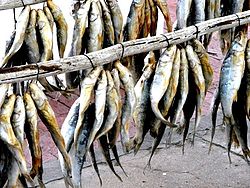Preparation
The ingredients for bokkoms consist of small (juvenile) mullet (fish), coarse salt and fresh water. The original West Coast way of preparing bokkoms starts with catching the small (juvenile) mullets (called "harders" in Afrikaans). A large square tank built out of bricks or stone is filled with a strong pickle made of around 50 kg of coarse salt and fresh water, to which the fish is added. As soon as enough fish is added to reach the top of the tank, two or three spades full of dry coarse salt is spread on top of the fish. Thereafter more layers of fish and salt are put on top until all the fish is covered in salt. A thick layer of salt is added to the top. This is left for one day. On the second day, a press made with wood with weights on top, is placed on the fish in the tank. The purpose of the press is to ensure that the guts of the fish is pressed flat so that it does not go bad. After the third day in the tank, the fish is taken out and is then stringed up in bunches of 10 to 25 fish each on a rope, making use of a fish needle which is pushed through the eyes of the fish. The bunches are then dipped 2 to 3 times in fresh water, before they are hung on scaffolds to dry.
Drying
The most suitable circumstances for drying is a lot of wind and not too harsh sunlight. At nighttime, the fish is brought under a roof to prevent it from drawing in damp, and the next day it is taken outside again to hang in the sun. The whole drying process takes about 5 days. More recently, people have started to make use of drying "ovens". This consists of a closed room with an electrical fan, in which the fish is hung. The fan blows heated air into the room. This simplifies the drying process considerably, since the fish does not need to be moved indoors every evening. This also allows drying to take place during the wetter winter months.
The bokkom industry
Bokkoms is a delicacy typical to the Western Cape of South Africa, and specifically the West Coast. Although it has a significant market in the Western Cape (where it is very popular and can be found in hotels, bars, bottle stores (in UK: off-licence), fish shops and beach kiosks on the beaches and holiday resorts), it has not been able to become a common product in the larger part of Southern African butcheries, fisheries and grocery stores like biltong has. It is, however, available for ordering and shipping through the internet in vacuum packed format. [6]
There is a vibrant bokkom industry in the "bokkom capital" of the world, Velddrif, on the West Coast of South Africa. [7] Around 95% of South Africa's bokkoms are produced in Velddrif, in a series of small individual factories located along the Berg river. [7] Each factory has its own small jetty on the river at the front of the factory. In the past, large schools of mullet was caught in the river and the jetties were used as a place to tie the fishermen's "bakkies" (small boats) to unload their catch. Because of over-fishing, the catching of mullet in the river is now prohibited and it must be netted in the open sea just off Laaiplek. [7]
Velddrif is the ideal place for the bokkom industry. It has access to the mullet just off the coast, its weather conditions are ideal for drying the fish (dry summers and relatively low rainfall), and it has access to huge amounts of sea salt as spring tide pushes the sea over the extensive salt pans (the largest salt factory in South Africa where salt is extracted from sea water, the Cerebos salt factory, is also situated there). [7] It also has access to fresh water in the form of the Berg river. It is thus no co-incidence that the bokkom industry originated and still continue to be situated in Velddrif. The well-known "Bokkomlaan" (Bokkom avenue) along the banks of the Berg river in Velddrif is a place where tourists can see large numbers of bokkoms strung up in bunches on rows of reed scaffolds along the side of the road.

A kipper is a whole herring, a small, oily fish, that has been split in a butterfly fashion from tail to head along the dorsal ridge, gutted, salted or pickled, and cold-smoked over smouldering wood chips.

Biltong is a form of dried, cured meat which originated in Southern African countries. Various types of meat are used to produce it, ranging from beef to game meats such as ostrich or kudu. The cut may also vary being either fillets of meat cut into strips following the grain of the muscle, or flat pieces sliced across the grain. It is related to beef jerky; both are spiced, dried meats; however the typical ingredients, taste, and production processes may differ.

Roe or hard roe is the fully ripe internal egg masses in the ovaries, or the released external egg masses, of fish and certain marine animals such as shrimp, scallop, sea urchins and squid. As a seafood, roe is used both as a cooked ingredient in many dishes, and as a raw ingredient for delicacies such as caviar.
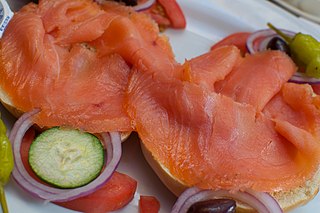
Lox is a fillet of brined salmon, which may be smoked. Lox is frequently served on a bagel with cream cheese, and often garnished with tomato, sliced onion, cucumbers, and capers.

South African cuisine reflects the diverse range of culinary traditions embodied by the various communities that inhabit the country. Among the indigenous peoples of South Africa, the Khoisan foraged over 300 species of edible food plants, such as the rooibos shrub legume, whose culinary value continues to exert a salient influence on South African cuisine. Subsequent encounters with Bantu pastoralists facilitated the emergence of cultivated crops and domestic cattle, which supplemented traditional Khoisan techniques of meat preservation. In addition, Bantu-speaking communities forged an extensive repertoire of culinary ingredients and dishes, many of which are still consumed today in traditional settlements and urban entrepôts alike.

The Reverend Stephanus Jacobus du Toit was a controversial South African nationalist, theologian, journalist and failed politician. In his younger years Du Toit did much to promote the Afrikaans language as a symbol of Afrikaner nationalism. Apart from the years 1882-8 when he was Superintendent of Education in the South African Republic, he lived in or near the town of Paarl in the Cape Colony. Disillusionment with the Kruger regime led him, in later years, to moderate his views. He was instrumental in initiating the translation of the Bible into Afrikaans and was a proponent of the Afrikaans language. He died an outcast.

Smoked fish is fish that has been cured by smoking. Foods have been smoked by humans throughout history. Originally this was done as a preservative. In more recent times fish is readily preserved by refrigeration and freezing and the smoking of fish is generally done for the unique taste and flavour imparted by the smoking process.

Fresh fish rapidly deteriorates unless some way can be found to preserve it. Drying is a method of food preservation that works by removing water from the food, which inhibits the growth of microorganisms. Open air drying using sun and wind has been practiced since ancient times to preserve food. Water is usually removed by evaporation but, in the case of freeze-drying, food is first frozen and then the water is removed by sublimation. Bacteria, yeasts and molds need the water in the food to grow, and drying effectively prevents them from surviving in the food.
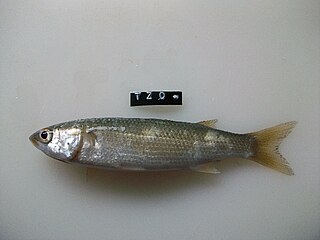
The South African mullet, also called a harder mullet or simply harder, is a species of mullet. It is found in South African coastal waters from Walvis Bay (Namibia) to KwaZulu-Natal, and grows to a maximum length of 40.5 cm. The person the specific name honours was not recorded by Andrew Smith when he described this species but it is most likely to be John Richardson (1787-1865), the Scottish naturalist, surgeon and Arctic explorer.

A buckling is a form of hot-smoked herring similar to the kipper and the bloater. The head and guts are removed but the roe or milt remain. They may be eaten hot or cold.
Johannes du Plessis Scholtz was a South African philologist, art historian, and art collector.
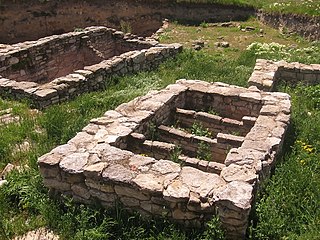
Fish preservation is the method of increasing the shelf life of fish and other fish products by applying the principles of different branches of science in order to keep the fish, after it has landed, in a condition wholesome and fit for human consumption. Ancient methods of preserving fish included drying, salting, pickling and smoking. All of these techniques are still used today but the more modern techniques of freezing and canning have taken on a large importance.

Hendrik Bernardus Thom was a Afrikaner professor and former Rector of the Stellenbosch University.

The Handwoordeboek van die Afrikaanse Taal (HAT), is the best known explanatory dictionary for the Afrikaans language and is generally regarded as authoritative. Compared to the Woordeboek van die Afrikaanse Taal (WAT) it is a shorter Afrikaans explanatory dictionary in a single volume. The latest edition of the HAT, the sixth, was published in 2015, 50 years after the first edition of 1965. HAT6 comprises 1,636 pages.
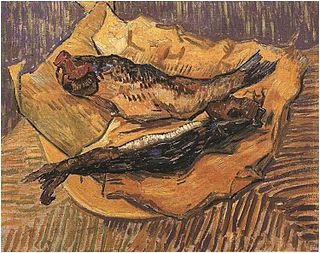
Bloaters are a type of whole cold-smoked herring. Bloaters are "salted and lightly smoked without gutting, giving a characteristic slightly gamey flavour" and are particularly associated with Great Yarmouth, England. Popular in the 19th and early 20th centuries, the food is now described as rare. Bloaters are sometimes called a Yarmouth bloater, although production of the product in Yarmouth appears to have now ceased in the town with the closure of its smoked fish factory in 2018. The bloater is also sometimes jokingly referred to as a Yarmouth capon, two-eyed steak, or Billingsgate pheasant.

Velddrif or Velddrift, is a coastal fishing town in the Bergrivier Local Municipality, Western Cape, South Africa. The town had a population 7800 in 2007 and is located on the estuary at which the Berg River flows into St. Helena Bay.

Herring are forage fish in the wild, mostly belonging to the family Clupeidae. They are an important food for humans. Herring often move in large schools around fishing banks and near the coast. The most abundant and commercially important species belong to the genus Clupea, found particularly in shallow, temperate waters of the North Pacific and North Atlantic Oceans, including the Baltic Sea, as well as off the west coast of South America. Three species of Clupea are recognized; the main taxon, the Atlantic herring, accounts for over half the world's commercial capture of herrings.
Anna Johanna Dorothea de Villiers was an Afrikaans South African writer, lexicographer, and educator from South Africa. She is best known for her contributions to Die Afrikaanse woordeboek and Woordeboek van die Afrikaanse Taal. After receiving her doctorate, she taught at the Technical College in Pretoria.
